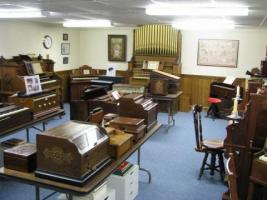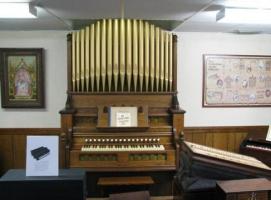
Lee Chaney had a life-long love of musical instruments, especially those with keyboards. Over the years he built a sizeable personal collection of instruments of a wide variety, even setting up a small museum in his home so that others could view his collection. Formerly a Professor of Educational Psychology at Jacksonville State University in Jacksonville, Alabama for over 40 years, Chaney retired to Clinton, NC. He died there on March 4, 2012.
Recently, his son, John Chaney, decided that the Estey Organ Museum in Brattleboro was an appropriate home for a number of these instruments. In addition to several Estey reed organs, the collection included instruments by other builders who had a historical relationship with Estey, notably Riley Burdett of Putney, as well as instruments illustrating the development of the American reed organ. Further, the collection consisted of framed posters about organ building and other important archival memorabilia.
Philip Stimmel, Managing Director of the museum, travelled to North Carolina and selected those items which most clearly illustrated the important role that Brattleboro played in the 19th and th century reed organ phenomenon in the United States. Windham County was a dynamic hub of activity in the field, and included such well-known builders as Joseph Jones, Riley Burdett, Henry Kirk White, Edwin B. Carpenter and Isaac Hines, all of whom were variously affiliated with Jacob Estey. The Chaney collection also included an organ built by Ross, West and Morse which was delivered to the Poultney, VT Historical Society for its museum of melodeons built in that town.
Perhaps the most important instrument returned to Brattleboro is an Estey Chapel Organ, Style H98. The organ is significant not only due to the large number of stops it contains, but also because of the beautiful golden pipe top it displays. While not needed to produce the tones of the organ, these pipe tops were much in demand as an eye-catching adornment. This organ will be on display in the lobby of the Brattleboro Savings & Loan bank for several weeks, and will be played there by local organists.
The manufacture of reed organs was a phenomenon which swept the United States from approximately 1835 to the 1950’s. Hundreds of builders dotted the country and competed for customers in the marketplace. These organs were cheaper than pianos, lighter, and did not require tuning, and quickly became the instrument of choice for the well-appointed family parlor. However, as the middle class became more affluent, they lost their appeal as the piano became the keyboard instrument of choice.



